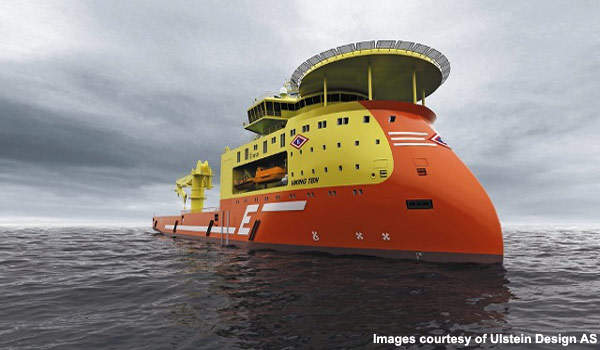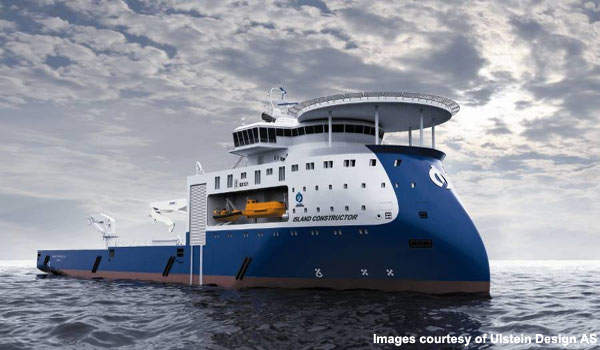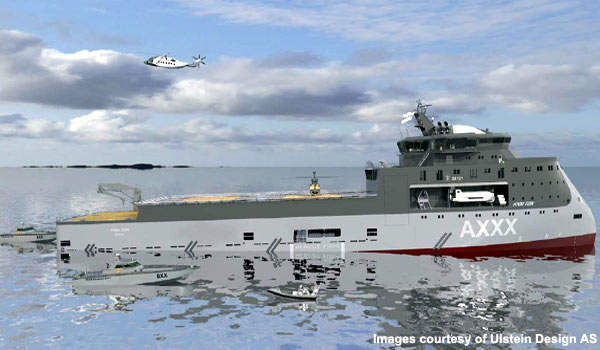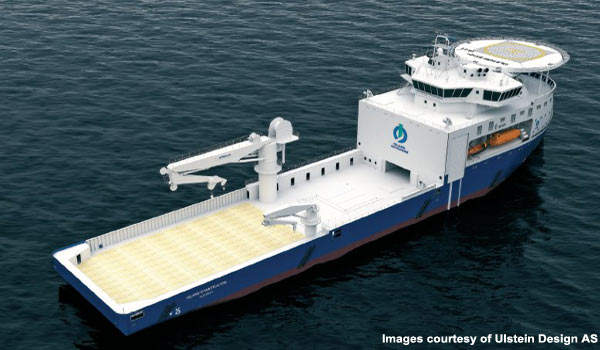Launched in February 2008 from the Ulstein Verft shipyards in Norway, the Island Constructor is the latest Ulstein X-Bow ship to join the fleet of Island Offshore Management AS. The ULSTEIN SX121-class ship was designed by Ulstein Design AS and constructed by Ulstein Verft.
The ship will be used in the oil industry for light well intervention operations.
The Island Constructor is the fourth Ulstein X-Bow vessel to be completed and the first in the Ulstein S-series (specialised vessels). The first ship was launched in 2006.
The vessel will be fitted with a large tower in order to carry out state-of-the-art well intervention offshore.
Ship construction began in 2006 and required Nkr600m. Ulstein Design will deliver 20 Ulstein X-Bow vessel designs to seven ship owners between 2008 and 2010. Four Ulstein ships are currently being constructed in China.
TECHNICAL
The vessel is 120.2m long, with a PP length between 112.3. It has a moulded breadth of 25.0m and a design draught of 7.0m. The depth to main deck is 10.0m. The maximum draught is 7.9m and the ship will be able to make a speed of 15kt. The vessel has a dead weight of 8,200t, a deck load of 5,600t and a cargo deck area of 1,400m².
The main generator can produce 13,820ekW. There are two main generator engines, each of 4,145 ekW at 900rpm, two main generator engines, each of 2,765 ekW at 900 rpm, two main azimuth propellers (pulling type, controllable pitch, frequency controlled) at 3,500kW, and two bow tunnel thrusters of controllable pitch, frequency controlled, with a power of 1,800kW.
There is also one swing-up compass thruster aft, controllable pitch and frequency controlled with a power of 1,800kW and one swing-up compass thruster fore, controllable pitch and frequency controlled with a power of 1,500kW.
The ship can hold 2,300m³ of fuel oil, 1,030m³ of fresh water and 6,000m³ of ballast water.
The vessel notation is Det Norske Veritas + 1A1, SF, E0, DYNPOS-AUTRO, CLEAN DESIGN,NAUT-OSV(LOC only), OPP-F, CRANE, COMF-V(3), COMF-C(3), LFL*, DK(+), HL(+), HELIDK.
DESIGN
The ship has a revolutionary bow shape designed to lower the impact on the environment and make the vessel safer in extreme weather conditions. The bow shape also means that the vessel can maintain speed while also saving fuel.
Offshore vessels with the Ulstein X-Bow system are designed to be able to maintain their speed, even in stormy weather. The company says vessels with the X-Bow design are 4%–7% more fuel-efficient than vessels with
conventional bows, depending on how they are operated. The inverted bow means vessels with this feature have exceptionally soft entry into oncoming waves.
WELL INTERVENTION SYSTEM
In August 2007, FMC Technologies signed a $25m contract to supply a Riserless Light Well Intervention (RLWI) system tower for installation on the Island Constructor. The system is intended for use by BP on its subsea wells in the North Sea over a three-year contract.
The Island Constructor will be able to carry out many types of operation, with ample space for a large deck area, a moonpool, an active 150t heave-compensated offshore crane, ROV hangar, diesel electric power plant and a helicopter deck. The vessel will be classified as an inspection, maintenance and repair/offshore construction vessel (IMR/OCV), and will be fitted for 90 people.












